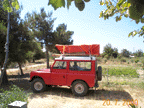 |
Destination... After driving 700 km (more than 400
miles) in a Series III Land Rover with two kids and a
banging boat on top. Only Series Land Rover owners can
appreciate this achievement. This place is by the Aegean
sea on the Gallipoli Peninsula, Canakkale, western
Turkey. |
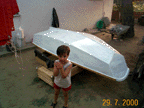 |
I first painted the inside and then the outside of
the hull. In this picture you see my daughter posing in
front of the boat. The first coat of paint has just been
applied to the outside. One advice I can give you is that
you should never ever try to paint a boat out in the open
unless you have absolutely no other chance. I had to wait
for calm days because the wind was blowing all kinds of
debris and dust. The insects and falling leaves from the
pine a few feet away were even worse. Because of this, I
had to apply four coats of paint only to obtain a fair
looking paint job. |
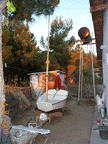 |
My opinion is that a bright finished boat (like the
Praamstra boat on the main page) would look better and I
would have done that if I could find ultraviolet
resistant varnish in Ankara. Failing at that, I decided
to paint her white and bright finish the dimensional
lumber only. This is the result. The mast, boom, gunwales
and the tiller have been varnished, and everything else
has been painted white. Her sail is orange-red (made of
the same cloth used to wrap her on the Rover). Two more
pictures of the finished boat follow. |
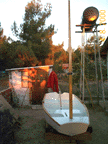 |
There is a lot of controversy on which paint to use
on epoxy (some paints may not be compatible with it and
may not cure). A group of paints called linear
polyurethanes are preferred by professionals. I would be
more concerned about paint if this were a 30 footer, but
for a boat of this size I suggest that you go for what is
cheaply available. Basicly, what I want from the paint is
that it must protect the epoxy from UV radiation and
offer some abrasion resistance. I chose a simple alkyd
based paint for the job. The rule of thumb here is to
apply many thin layers instead of fewer thick layers.
Also, don't forget to sand in between layers using 220
grit paper. |
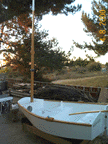 |
The problem I have noticed with Turkish-made
alkyd-based synthetic paints is that they take an
extremely long time to dry, especially if you apply a
thick layer. I have tried two different brands and both
showed the same behavior. Part of the problem may stem
from the thinner because nowadays thinners look like oil.
Oddly, varnishes do not seem to have this problem. |
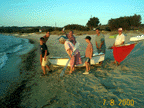 |
Launching...Family members carrying her ashore. You
can see one of my cousins waving the beer that we used
for celebrating her launch (rituals must be followed).
Champagne is reserved for the next (=bigger?) project. |